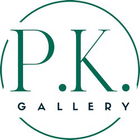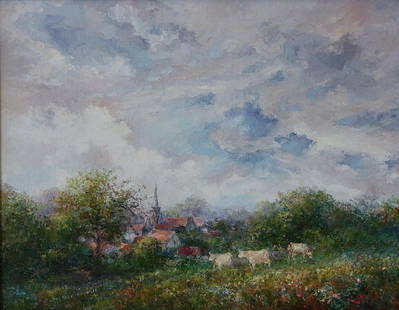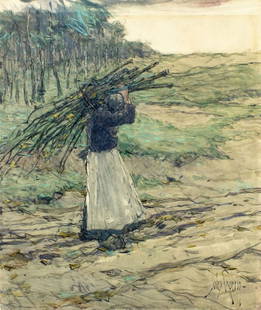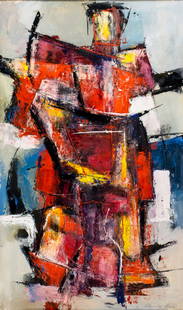
James Hope American 1818-1892 Framed Oil Painting
Similar Sale History
View More Items in Paintings
Related Paintings
More Items in American Paintings
View MoreRecommended Art
View More




















Item Details
Description
"Landscape artist and Union Army officer, James Hope was one of several artists-Union and Confederate-who translated their combat experiences into distinguished paintings. However, Hope differed from some of his peers because he was already a successful artist and was well-embarked upon a noteworthy career when he joined the Union Army in May 1861 at the age of forty three. Having painted portraits and then landscapes in Canada and around his adopted home in Vermont, Hope began exhibiting works at the American Art Union in 1849 and at the National Academy of Design in 1854 and was elected an associate member of the NAD in 1871. Going to war gave Hope new subject matter and led him to embrace a genre that Sanford R. Gifford-another soldier-artist-called "historico-military" painting; that is, depictions of battles, battlefields, and other significant wartime people and events. His participation in the battles he depicted and his careful attention to geographical and historical verisimilitude made his historico-military works the hallmarks of his career.James Hope combined his time-and-place interest with his traditional landscape renderings in the painting that is now titled View from Sunset Rock, Lookout Mountain, circa 1878. The painting is a tranquil depiction of a place that had been the site of three Union victories that made up the Chattanooga Campaign. Victory at the Battle of Lookout Mountain, November 24, 1863, required Union forces both to scale Lookout Mountain south of Chattanooga and defeat Confederate troops atop it. The Battle of Wauhatchie, October 28-29, 1863, had taken place on the vast field that Hope depicted from atop Lookout Mountain. That battle secured the Union supply line that made possible the success at Lookout Mountain on twenty-fourth and the Battle of Missionary Ridge the following day. The Tennessee River at Moccasin Bend dominates the background; the small structure in the distant background is Fryar's Farm House, which is depicted on contemporaneous topographical maps; and the creek in mid-view is Lookout Creek. Hope also painted another scene titled Chattanooga from Lookout Mountain, 1878. That painting complements View from Sunset Rock because it depicts the eastern side of Moccasin Bend and the city of Chattanooga in the distant background. The conventional mountaintop views of these paintings contrast greatly with the three battles that centered upon Lookout Mountain and Summit Rock, the large outcrop that dominates both paintings. Chattanooga from Lookout Mountain is in the collection of the Hunter Museum of American Art at Chattanooga, TN.James Hope was born November 29, 1818, at Drygrange Lodge, Roxburghshire, Scotland. He immigrated with his father to Canada and upon his father's death circa 1830 he found work as an apprentice wheelwright in Vermont. By 1843 he had discovered his artistic talent and began painting portraits and landscapes. He briefly settled in Montreal, Canada, and then returned to Castleton, Vermont, where he taught at the Castleton Academy and began to build his reputation. Answering the call to arms at the start of the Civil War, Hope helped to organize the Second Regiment of Vermont Infantry in May 1861. Elected captain of the regiment, he served with the regiment through nine battles, including the First Battle of Manassas Junction, July 21, 1861, and the Battle of Antietam, September 17, 1862, the bloodiest single day in American history. After the Battle of Fredericksburg, December 13, 1862, Hope resigned his commission because of persistent illness. The Second Vermont went on to fight in a total of twenty eight major engagements, including the Battle of Gettysburg, where, on July 3, 1863, it was in the center of the line that repulsed George Pickett's Charge.Retiring in the middle of the war, Hope immediately began creating fully-realized battlefield scenes, most of which were based upon his sketches, studies, and personal recollections. While he returned to landscape-painting and, in fact, listed his occupation as "landscape painter" in the 1880 Federal Census, he devoted much of the rest of his life painting large and small artworks that depicted the horrors and heroism he had witnessed in combat. One painting, General Slocum and Staff near Chickahominy, was painted in 1862, while he was still in service. He painted a finished Antietam battle scene, circa 1862, titled 7th Maine Attacking over the Sunken Road through the Piper Cornfield, and made a larger version of this work in later years. Winter Quarters of the 26th New Jersey Volunteers, was exhibited in March 1864. Hope's notes on the back of The Army of the Potomac, at Cumberland Landing indicate that he painted it in April 1865 "from a sketch taken by him on the spot." He had painted an earlier version of this work in 1864.In 1866 Hope collaborated with former Army surgeon George T. Stevens to produce illustrations for Stevens's Three Years in the Sixth Corps: A Concise Narrative of Events in the Army of the Potomac from 1861 to the Close of the Rebellion, April, 1865 (Albany: S.R. Gray, 1866; New York: Van Nostrand, 1870). The work contained twenty illustrations, seven of which Stevens stated he had prepared from his own sketches. At least seven of the remaining images were taken "from the pencil of the well-known artist, Captain J. Hope, and all have been submitted to him for is finishing touch." It from this level of immediate engagement with images of war that Hope entered the conflict an artist; practiced his craft while in the military; and immediately took up his profession when the guns had fallen silent.By far the summit of his achievement as a historico-military painter are his five large murals that depict the Battle of Antietam. During the battle Hope made many sketches and apparently some small-scale studies. With these in hand and relying upon published and unpublished accounts he worked for many years-starting and completion dates are uncertain- the works were finished and displayed at his studio at Watkins Glen, New York, prior to his death on October 29, 1892. Unsold, they were stored for decades in his studio but were damaged in a flood during the 1930s that also destroyed completely many of his works. After being owned by a private collector from the 1930s until 1979, the paintings were purchased by the United States National Park Service, which restored them and now display them at the NPS Antietam National Battlefield. Hope's Antietam paintings are large, first-hand representations of the great battle. Four of them are 5.5 by 12 feet and the fifth, After the Battle: Bloody Lane, is 8.5 by 16 feet. They are panoramic in size and offer views of the dynamics of the battle at five stages but their depictions of dead men piled up at Bloody Lane and strewn across the battlefield in Artillery Hell, Wasted Gallantry, and A Fateful Turn-names that Hope gave to the works-dominate the content. A large study (4.5 x 10.5 feet) for a sixth large painting, Army of the Potomac Encamped at Cumberland Landing on the Pamunkey, had been near completion in January 1865, when General George B. McClellan saw it in Hope's studio and praised it for its authenticity and its ability to transport him to the scene. In 1904 a large number of Hope's paintings were presented for sale. They were described in Catalogue of Eighty-three Famous Canvases by the Late James Hope, A.N.A. [New York: Fifth Avenue Art Galleries, 1904]. The five Antietam paintings and Army of the Potomac were on offer and the catalog descriptions of each of these works had been written by Hope at some time prior to his death. A poet as well as a painter, Hope described the works as accurate records as well as valuable aids to recollection for veterans of the battle and for successive generations who had not witnessed the war.Hope's Lookout Mountain paintings are different: the significance of the location could never be lost on any nineteenth or early twentieth-century viewers but the scene is cleansed of battle and given back to nature and quiet human cultivation. When Chattanooga from Lookout Mountain, the companion piece of View from Sunset Rock, was offered for sale in 1904, it was described as a canvas that presents in all the freshness and aroma of its world-lauded loveliness, a scene of unrivaled panoramic effect. The winding Tennessee and its luxuriant, undulating slopes are seen from the craggy heights of Lookout. Bathed in radiant sunlight lies the City of Chattanooga close-clasped by Moccasin Bend. The same observation might well serve to describe View from Sunset Rock and to be certain, both differ greatly from the mammoth scenes of death and destruction that are his Antietam paintings." ReferencesCatalogue of Eighty-three Famous Canvases by the Late James Hope, A.N.A. [New York: Fifth Avenue Art Galleries, 1904]Harvey, Eleanor Jones. The Civil War and American Art. Washington, DC: Smithsonian Institution. 2012. (Source of S.R. Gifford's phrase "historico-military paintings")"James Hope," Smithsonian Institution Research Information Service, accessed February 3, 2017.Stevens, George T. Three Years in the Sixth Corps: A Concise Narrative of Events in the Army of the Potomac from 1861 to the Close of the Rebellion, April, 1865. Albany: S.R. Gray, 1866; New York: Van Nostrand, 1870 Providence: Property of the Stern Family, Well Established Family in the City of Manhattan, New York. Collecting Fine Art for Several Generations Approximately: 37 in x 16.5 x 1 in
Condition
All items featured in our Catalogue are pre-owned and may display typical age-worn condition such as chips, nicks, peeling, repainting and or in more extreme cases cracks and or loss. Please carefully review all photos and please be encouraged to reach out to us via Message if you would like additional photos and or condition report.
Buyer's Premium
- 25%
James Hope American 1818-1892 Framed Oil Painting
Estimate $25,000 - $50,000
5 bidders are watching this item.
Shipping & Pickup Options
Item located in Bayside, NY, usSee Policy for Shipping
Local Pickup Available
Payment
Accepts seamless payments through LiveAuctioneers

TOP












































![Oil Paintings: Monks Playing Cards (2) [139841]: Lot of two framed oil paintings, 15 x 18 inches of monks playing cards. One monk is laughing, the other befuddled.](https://p1.liveauctioneers.com/2699/331494/178785199_1_x.jpg?height=310&quality=70&version=1717094654)





















![Emilio Grau-Sala "Sur la Plage" Oil on Canvas: Emilio Grau-Sala (Spanish, 1911-1975), "Sur la Plage" [On The Beach], Oil on Canvas, 1958, signed "Grau Sala" lower right, signed, inscribed "Trouville", dated, and titled to verso. Image: 21.5" H x 2](https://p1.liveauctioneers.com/5649/328023/176731071_1_x.jpg?height=310&quality=70&version=1714409606)














